Contents
One of the secrets of successful gardening is the correct selection of plants for their compatibility with each other. The list of vegetables that can be planted next to peas on the same bed is not too extensive. It is advisable to familiarize yourself with them before growing a crop in order to ensure a good harvest.
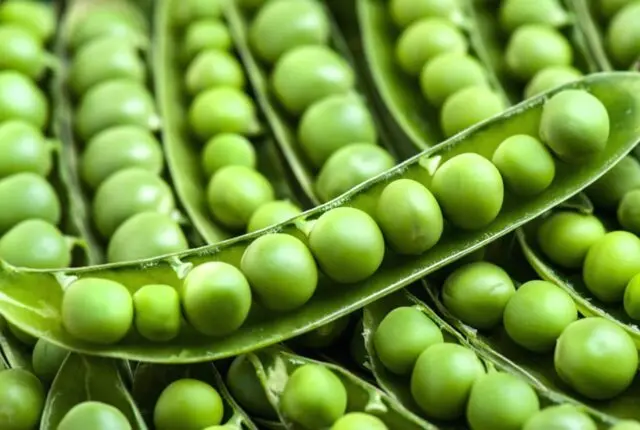
Proper agricultural technology is the main condition for the yield of any vegetables.
How crop compatibility affects yield
Compatible crops are those that, when grown on the same bed, not only do not suppress, but also have a positive effect on each other, creating a favorable microclimate that contributes to normal development and increased productivity.
The right neighborhood makes it possible:
- get fresh vegetables from early spring to late autumn;
- increase the yield of crops grown nearby;
- improve the quality of vegetables and berries;
- rational use of the usable area of the garden;
- prevent the development of diseases and pest attacks;
- attract more insect pollinators;
- increase the profitability of the site by compacting plantings of vegetables with different ripening periods.
In addition, the habit of planting compatible crops on the same or adjacent beds that require the same soil composition and identical care makes it possible to control the content of nutrients in the soil and ensure proper plant nutrition.
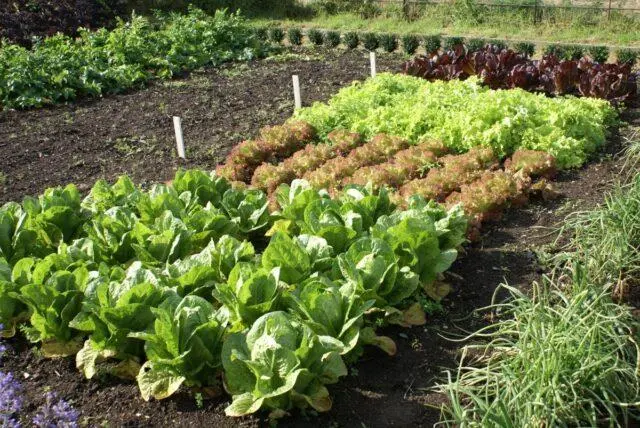
Proper neighborhood will benefit all plants
Pea compatibility with other crops
You can find a suitable place for peas even in a small area. This representative of legumes is flexible, not aggressive and gets along well with nearby plants.
A powerful root system loosens the soil well, thereby providing oxygen access to the roots of other plants, and white or purple flowers exuding a pleasant aroma attract insects, which at the same time pollinate crops growing with it on the same bed.
Legumes are distinguished by their ability to saturate the soil with nitrogen, which makes the neighborhood of peas very useful. Having long roots allows them to extract nutrients from deep layers of the soil, leaving what is closer to the surface for other crops.
Planting this plant nearby is also recommended due to the presence of lush tops, which not only prevents the evaporation of moisture from the soil, allowing you to reduce the frequency of watering, but also inhibits the growth of weeds in the garden.
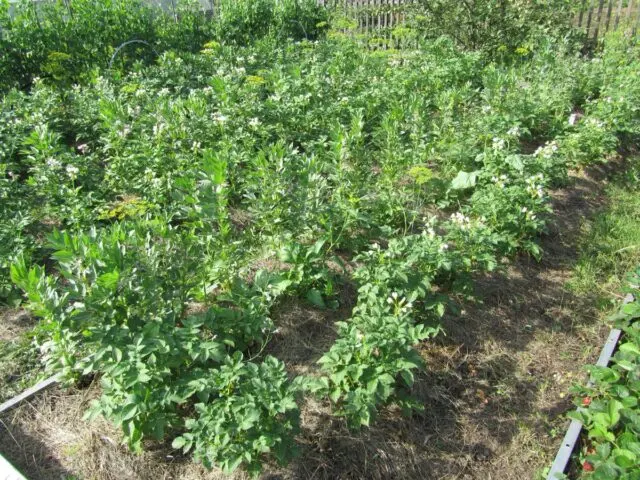
Neighborhood with legumes like many plants
How to plant peas in one garden
The yield of peas will largely depend on which neighbors grow with him on the same bed.
Good partners for this culture can be:
- Strawberry. Located in the upper soil layer, the fibrous root system of strawberries is so small that it is unlikely to harm nearby plants, and even more so peas, which are able to penetrate deeper layers of the soil. If you plant this vegetable with strawberries, you can get a good harvest of both crops.
- Zucchini, squash, pumpkin and cucumbers. All these vegetables actively consume nitrogen, which is fully provided by a properly selected neighbor. And insects flying to the fragrant flowers of legumes, at the same time pollinate representatives of pumpkin.
- Cabbage. This neighborhood is good for her too. The legume representative will loosen the soil with its roots and protect the neighbor from rotting. Gardeners recommend planting Beijing cabbage next to it, the taste of which becomes more pleasant and sweet.
- Potato. The tradition of sowing peas along with this vegetable appeared many years ago. And this is not surprising, because the presence of legumes helps to improve crop yields. In addition, if you plant peas nearby, it will scare away pests from potato bushes, including the Colorado potato beetle, which saves on insecticides.
- Carrot. The essential oils contained in carrot tops can repel harmful insects. If you plant legumes next to carrots, you can get a good harvest of both crops.
- Beet. Such neighbors get along well on the same bed. If you plant them together, the peas will not take food from the root crop, because its roots are longer, and the growing beets nearby will serve as a good support for the neighbor, which will eliminate the need for his garter.
- Radish, daikon. A good option is to plant legumes next to such vegetables. It has been noticed that such a neighborhood improves not only the yield, but also the taste of root crops.
- Corn. This culture gets along well on the same bed next to peas, which fully provides it with nitrogen and protects the roots from overheating. If planted side by side, tall corn will provide good support for trailing legumes.
- Mustard. Actively absorbing the nitrogen necessary for its growth, a nearby crop provides peas with useful substances that improve its fruiting.
- Spices. The essential oils found in mint, sage, rosemary, and other spices of this type help repel harmful insects. This benefits both the herbs and nearby neighbors.
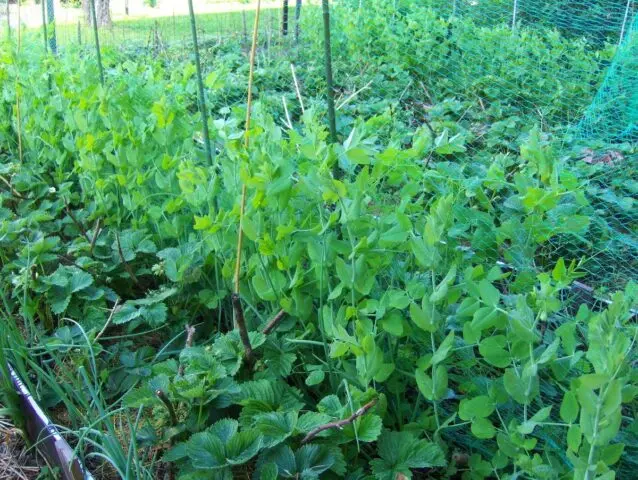
Even with a well-chosen neighborhood, it is better not to refuse to tie peas
What is better not to plant peas
Despite its useful properties, this vegetable may not be a good neighbor for everyone. It is not recommended to plant it on the same bed with such plants:
- Onion and garlic. The roots of these vegetables secrete phytoncides – special substances that can inhibit the growth of legumes, so such a neighborhood of peas will definitely not benefit.
- Tomatoes. It is also better not to plant tomatoes next to peas. Such a neighborhood may not be the best way to affect the yield of both vegetables.
- Fennel. This is an aggressor that is able to suppress all nearby growing plants. Only cilantro and coriander can resist fennel. But peas should not be planted with him.
- Sunflower. It is also one of the aggressors that can oppress neighbors, so it is better not to sow legumes with it. Moreover, according to experts, sunflower occupies almost the last place in the pea crop rotation, respectively, it is not recommended to plant it after this crop.
- Basil and wormwood. Neighborhood with herbs that have a specific aroma reduces the viability of the plant and gives the fruits a bitter taste.
You should not plant it in close proximity to alfalfa and clover, as well as in the shade of spreading trees and shrubs.

Peas growing next to onions will not be able to actively develop and therefore will not give a good harvest.
The best predecessors for peas
Crop rotation will help to get a good harvest and prevent the accumulation of pathogenic microorganisms in the soil, that is, the alternate cultivation of different annuals on the site.
With a well-designed schedule, previously planted plants not only do not impoverish or infect the soil, but also help to increase the yield of vegetables and berries next year. At the same time, each subsequent crop should replenish the stock of nutrients in the soil that was used up by their predecessors.
So, for example, in order to get a good crop of legumes, you need to know, after which you can plant peas in open ground.
Legumes will feel fine after many plants, except for their “relatives”, that is, representatives of this family.
The ideal predecessors of peas in crop rotation are: potatoes, cabbage, cucumbers, pumpkin, zucchini, dill, corn. You can plant it after strawberries, strawberries and carrots.
But on a plot previously sown with cereals, it is better to have a vegetable, provided that the beds are well cleaned of straw and weeds.
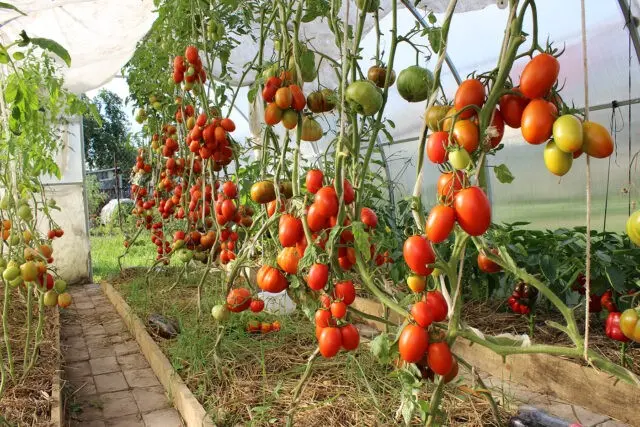
The next year, peas can be safely planted in the garden after tomatoes.
Is it possible to sow peas after peas
Oversaturated with nitrogen soil (namely, this is what it becomes after legumes) is the least suitable for growing vegetables. For this reason, it is impossible to plant peas after peas the next year. Another time, legumes in this area can be sown no earlier than in four years.
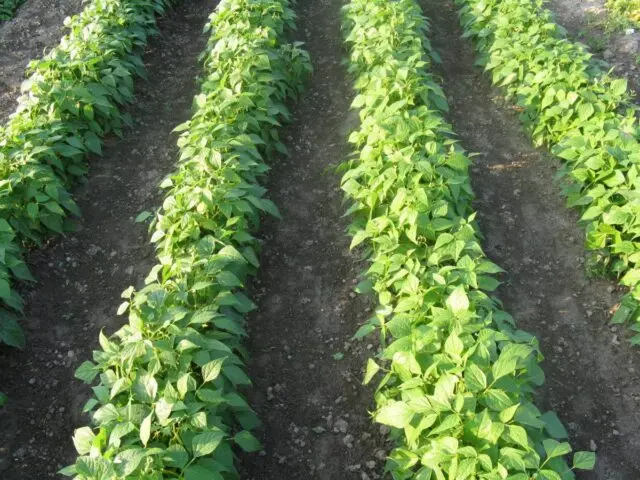
It makes no sense to plant peas after beans – there will be no good harvest
What can be planted next year after peas
The beneficial properties of legumes make it possible to use representatives of this family as green manure.
Embedding the tops of the plant in the soil:
- helps to saturate it with useful substances;
- improves soil structure;
- provides a favorable environment for the development of beneficial microorganisms.
Therefore, the next year after peas, almost all cultivated plants can be planted, except for the legumes themselves.
Conclusion
Next to the peas, you can plant such plants that will not interfere with its growth. The right choice of neighboring crops will help not only to grow a good harvest, but also to maintain soil fertility, which is very important in any agricultural economy.









